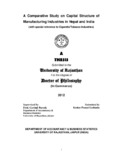Please use this identifier to cite or link to this item:
http://archive.nnl.gov.np:8080/handle/123456789/69| Title: | A comparative study on capital structure of manufacturing industries in Nepal and India: with special reference to cigarette/tobacco industries |
| Authors: | Gadtaula, Keshav Prasad |
| Keywords: | Tobacco industries -- India Tobacco industries -- Nepal Capital structure - industry |
| Issue Date: | 16-Jan-2018 |
| Abstract: | Capital Structure is equally significant to private and public companies -be it manufacturing or non-manufacturing. Similarly, the optimum capital structure is achieved only when long term debt and equity capital are effectively and efficiently mixed up. In the context of Nepal and India, most of the manufacturing companies rely heavily on debt contrary to service industries that prefer equity than debt. Moreover, Multinationals focus on long term borrowing primarily through FDI. Indian firms regard internal equity (retained earnings) as preliminary, then debt and finally the external equity financing. Considering the capital structure of Nepalese firms, they accompany high levered policy; however the long-term debt ratio is significantly low. The signs of estimates suggest that both pecking order and trade-off theories are at work in explaining capital structure of Nepalese companies. It can thus, be said that there exists similar pattern of capital structure between Nepalese and Indian manufacturing firms but the optimum utilization of Indian firms are relatively very much better in comparison to Nepalese one. In the mean time, various statistical, econometric tools and methods have been applied for meaningful interpretation and results. For drawing the conclusions, null hypothesis has been formulated and tested by the method of student –‗t‘ values. Similarly, financial ratio, percentage analysis and factor analysis have been computed and interpreted for clear picture of capital structure management of tobacco industries in Nepal and India. The research design approach uses descriptive statistics and econometric models along with inferential analysis. More precisely, it also examines the selected variables of tobacco companies through correlation and regression, inferential analysis like t test, F test and chi-square test along with Durbin Watson test, cointegration test and chow breakpoint test. |
| Description: | A thesis submitted to the University of Rajasthan for the degree of Doctor of Philosophy in commerce, Department of Accountancy & Business Statistics, University of Rajasthan, Jaipur, India, 2012. |
| URI: | http://103.69.125.248:8080/xmlui/handle/123456789/69 |
| Appears in Collections: | 300 Social sciences |
Files in This Item:
| File | Description | Size | Format | |
|---|---|---|---|---|
| A Comparative Study on Capital Structure of Manufacturing Industries in Nepal & India - Keshav Gadtaula.pdf | 3.63 MB | Adobe PDF |  View/Open |
Items in DSpace are protected by copyright, with all rights reserved, unless otherwise indicated.